This article was originally posted to DrivingSales.com
Texting has come a long way since the days of flip phones and message limits. What was once a communication channel reserved only for our closest friends and family is now a common way we interact with businesses.
This evolution isn’t exactly new, but were still a bit surprised with some of the stats that came out of our 2020 Dealership Service Retention Report. For the nearly 2,000 dealership service customers we surveyed, texting wasn’t just a popular communication method. It was consumers favorite way to receive communications from a dealership – by a long shot.
Texting Preferred Over Calls by Nearly 3 to 1 During Service
When we asked our research participants to identify their most preferred way to hear from a dealership during a service visit, 60% of them identified text messages. A phone call was the second most common choice, but it was picked by only 22% of respondents, trailing texting by a significant margin. In fact, phone calls beat out email by just 7%.
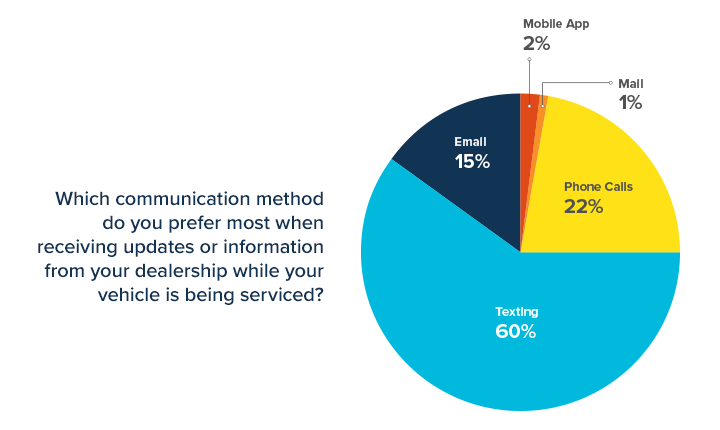
So if your dealership is still questioning whether customers are open to getting texts from you, wonder no more. Not only are they open to it, but the majority of them actually prefer it.
What about more senior customers? Yes, them too. Texting was the preferred communication method for every age group we surveyed. While the margin between texting and calls wasn’t as wide for customers 55 and above, they were still twice as likely to prefer a text over a call.
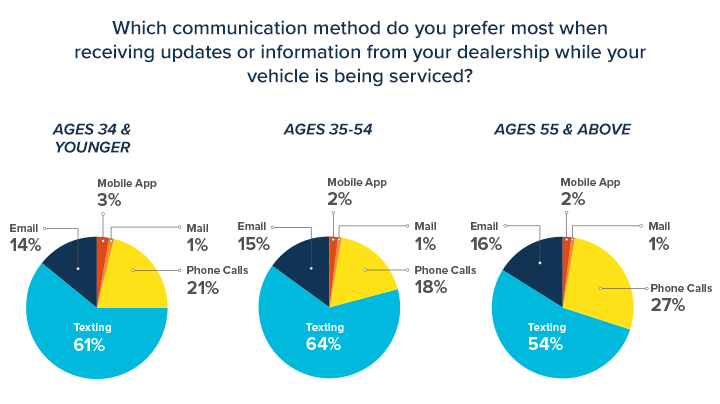
In addition to figuring out how customers wanted to be contacted while their vehicle was getting serviced, we also wanted to know what they preferred for the less immediate communications between visits. It turns out texting is pretty popular for that as well.
Texting Is Second Most Popular Preference Between Service Visits
Email has long been the king of non-urgent customer communications, and our research shows that texting hasn’t dethroned it yet. 50% of the service customers we surveyed prefer to receive emails over other communication methods between service visits.
However, texting does have a strong hold on second place. Nearly a third of the people we surveyed prefer texts (32%), followed by phone calls (12%), mail (4%), and a mobile app (2%).
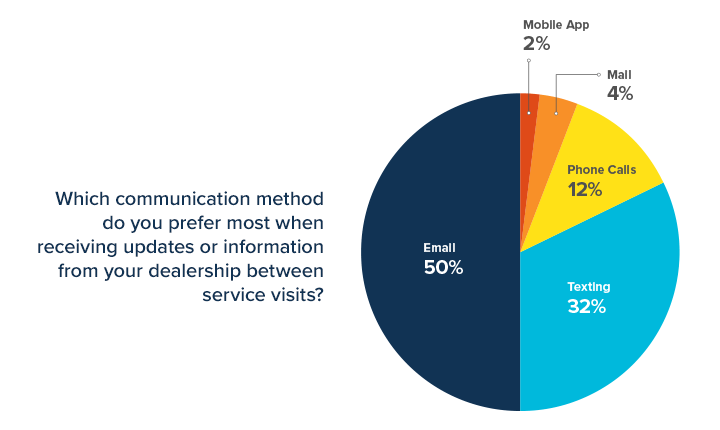
Again, the preferences stayed in the same order across age groups. About the same percentage of customers ages 34 and younger preferred texting as those 35-54 (37% and 36% respectively). For people 55 and above, they were slightly less likely to prefer texting (23%), with email making up the majority of the difference.
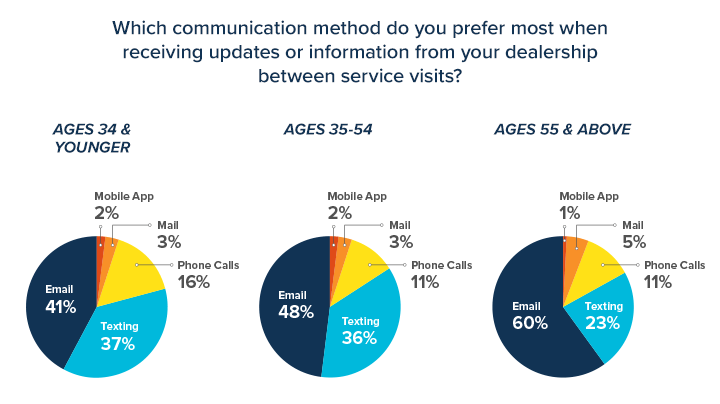
We see two big takeaways for dealerships here:
First, maintain your email strategy. It seems that questions come up every year about whether email is dead or dying – this data clearly shows that it’s still an effective tool.
Second, texting shouldn’t just be used for real-time communication while you’re servicing a customer’s vehicle. It can also be a great way to reach customers between service visits for things such as service reminders.
There’s one caveat to this data we want to mention. The question we asked was for participants to choose their most preferred communication method, and they were only able to pick one. So, while mail didn’t perform well as a top choice, we know from our work with dealerships that direct mail is still a valuable tool for driving business.
Dealerships May Not Be Keeping Up
So how are dealerships’ communication channels lining up with their customers’ preferences? It turns out that there is some alignment, but many dealerships still have some work to do.
Almost 90% of people surveyed get emails from their dealership. This shows that dealerships have a good handle on the most preferred format for messages between service visits.
However, more than 40% of people surveyed don’t get any texts from their dealerships. If the data about communication preferences is clear about one thing, it’s that the dealerships that haven’t adopted a solid strategy for sending text messages to customers should start now.
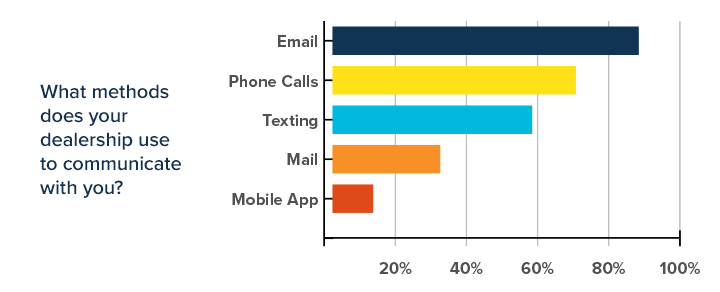
But when it comes to modernizing communications with customers, dealerships may not want to stop there.
What’s Next for Dealership Communication?
At DriveSure, we’re laser focused on helping dealerships bring more customers back to their service department more often. In addition to our suite of renewable, value-added benefits like roadside assistance and tire coverage, we help dealerships send the most effective service-reminder messages possible.
Over the last year or so, we’ve introduced a new form of service reminders called our Digital Pass. Among other functions, it allows customers to get app-like notifications on their smartphone when it’s time to return to the dealership’s service department.
Since this is a brand new form of communication in the industry, we wanted to gauge dealership service customers’ reaction to it in this survey. To be honest, even we were surprised by what we found.
Over half of the participants told us they would be likely or very likely to download a digital reminder notice on their smartphone to receive service reminders. Based on this response, we’re confident that smartphone notifications through tools like the DriveSure Digital Pass will be the next evolution in modern communication with your customers.
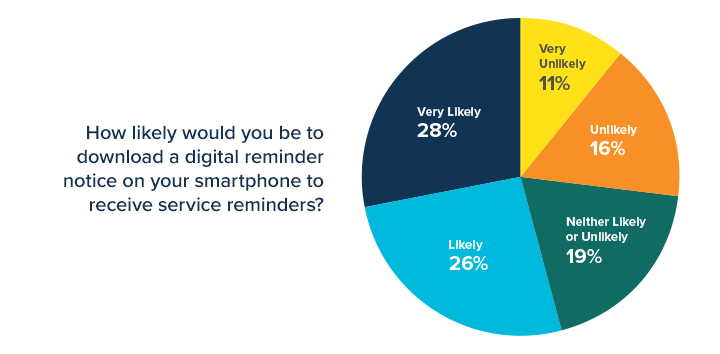
What Dealerships Should Do
Dealerships that aren’t yet texting customers during and between service visits, should begin looking into the technology that makes this easy. For those that already text customers, begin thinking about what’s next on the horizon for effective customer communications. If you need help implementing texting or smartphone notifications, or you just want to boost retention and service visit frequency, we’d be happy to chat.
Otherwise, be sure to grab a free copy of our 2020 Dealership Service Retention Report for more insights from nearly 2,000 dealership service customers about why they return for service, why they don’t, and what your dealership can do about it.
The 2020 Dealership Service Retention Report
INSIGHTS FROM NEARLY 2,000 DEALERSHIP CUSTOMERS
Learn why customers choose to return to their dealership for service and why they don’t. Plus, we reveal your biggest opportunities for encouraging customer loyalty.


